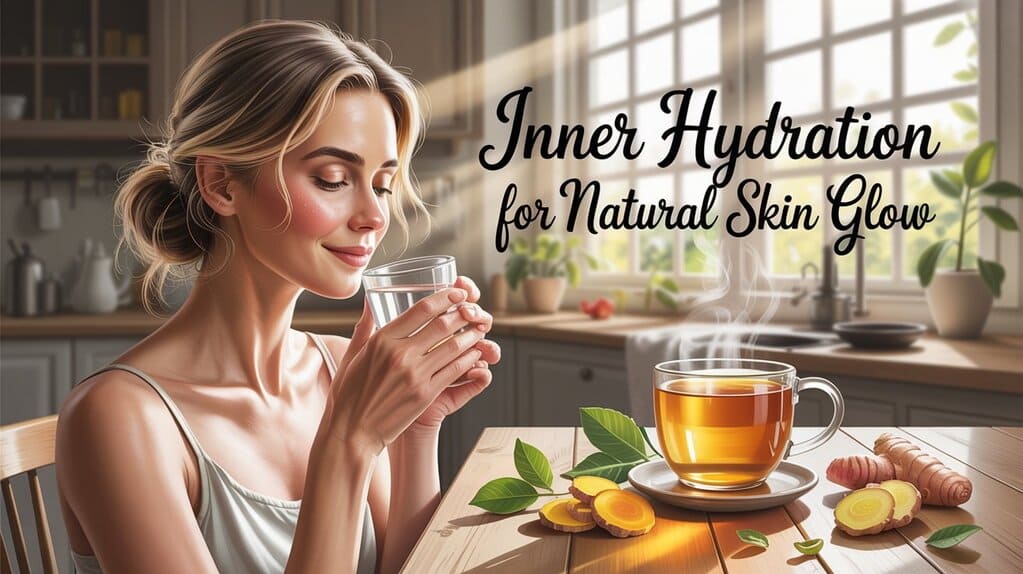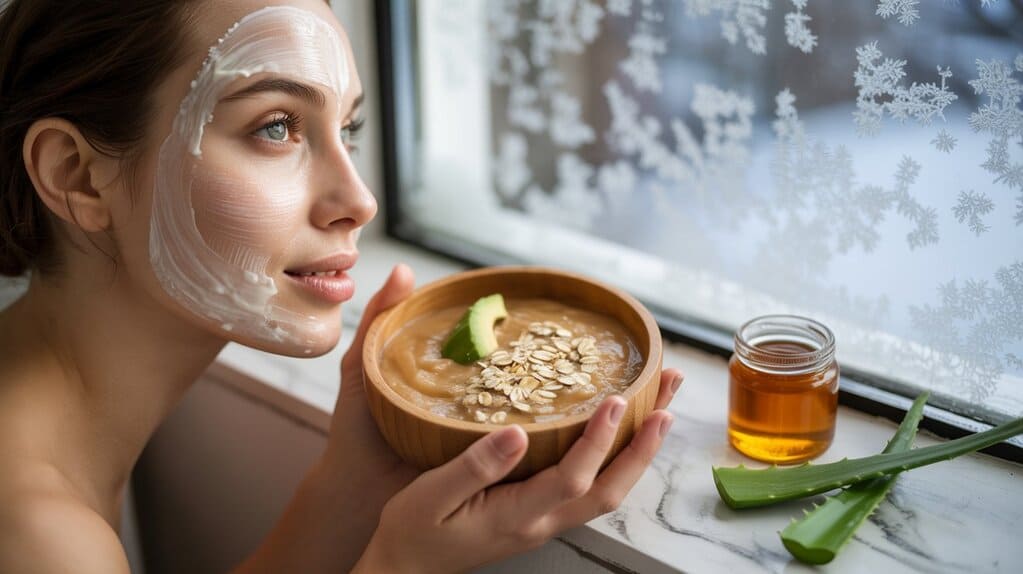
Introduction
Autumn brings cozy sweaters, crisp air—and a real challenge for your skin. The shift from warm, humid summer conditions to cooler, drier autumn weather commonly leads to dryness, tightness, flaking, increased sensitivity, and visible loss of radiance. A smart autumn routine blends nutrition from within (diet, supplements, and hydration) with targeted skin care from outside (cleansing, barrier repair, and protection). This article gives an evidence-informed, SEO-friendly guide to seasonal skincare: what changes in your skin to expect, which nutrients and ingredients really help, an easy practical routine, and cited scientific studies from Asia, America, and Europe to support the recommendations. PubMedPMC
Why autumn is different for your skin (short science primer)
As seasons change, measurable skin physiology changes as well: transepidermal water loss (TEWL), stratum corneum hydration, and skin pH can shift between warm and cool months, making the skin drier or more reactive. Multiple studies have documented seasonal variation in TEWL, hydration and skin barrier function—findings that explain why many people feel their skin is “worse” in fall and winter. PubMedPMC
Key takeaway: protect and rebuild the skin barrier and prioritize hydration and antioxidant support as temperatures and humidity fall. PMC+1

Body
Part A — Nutrition from within: what to eat and why
Healthy skin begins with a balanced diet that supplies building blocks (protein, essential fatty acids), antioxidants (vitamins C and E, polyphenols), micronutrients (zinc, selenium), and hydration. Recent reviews and consensus in nutritional dermatology highlight a set of nutrients linked to improved skin barrier, elasticity, and reduced photo-oxidative stress. PMC+1
Key nutrients and practical sources
| Nutrient | Benefit for Skin | Food sources / notes |
|---|---|---|
| Protein (collagen peptides, amino acids) | Supports dermal matrix and wound repair; may improve hydration and elasticity with consistent supplementation. | Fish, poultry, legumes, collagen peptides (supplements). EatingWell |
| Vitamin C | Essential cofactor for collagen synthesis and antioxidant protection. | Citrus fruits, berries, kiwi, peppers. PMC |
| Omega-3 fatty acids | Support barrier function, reduce TEWL and inflammation. | Fatty fish (salmon, mackerel), walnuts, flaxseeds. Wiley Online Library |
| Vitamin D | Immune modulation of skin; consider status check in low-sun months. | Sun exposure, fortified foods, supplements when deficient. PMC |
| Zinc & Selenium | Wound healing, antioxidant enzymes, sebum regulation. | Shellfish, nuts, whole grains. PMC |
| Polyphenols (e.g., green tea, resveratrol) | Antioxidant, photoprotective effects. | Tea, berries, dark chocolate (moderation). ScienceDirect |
Practical tip: prioritize whole foods first; add targeted supplements only if dietary intake is inadequate or a clinician recommends them (for example, Vitamin D in deficiency). Reviews indicate several supplements can support skin quality, but results vary by product and study quality. PMC+1
Hydration and lifestyle
Drink water regularly and include water-rich foods (cucumber, melon, soups). Limit excessive alcohol and high-sugar diets which can worsen inflammation and skin aging. Sleep, stress management, and moderate exercise support circulation and skin repair.
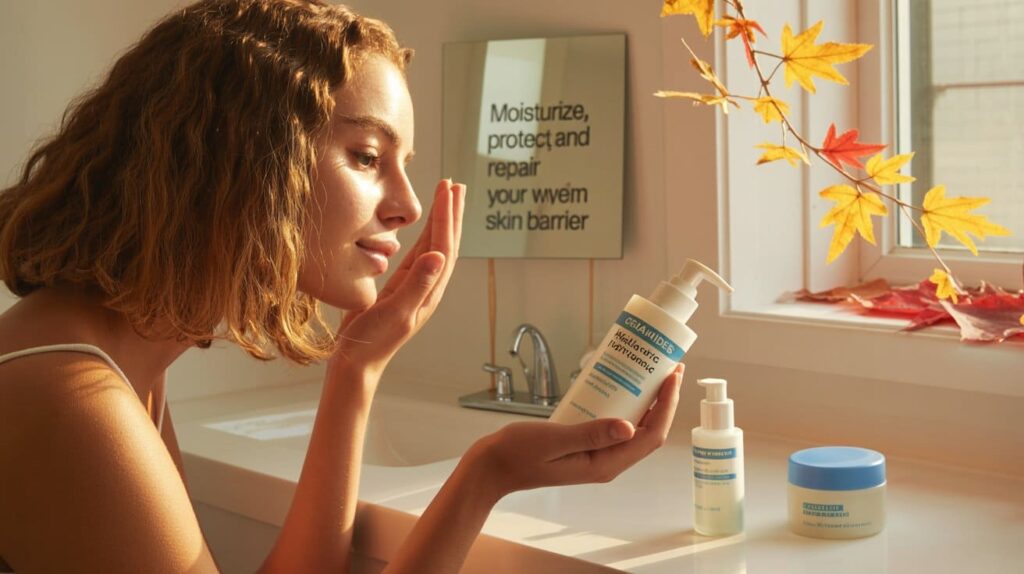
Part B — Skincare from outside: ingredients and routine for autumn
A minimal, effective autumn skin care routine focuses on gentle cleansing, barrier repair, targeted active ingredients, and daily sun protection.
1. Cleanse gently
Switch to a mild, non-foaming cleanser if your skin feels tight. Over-stripping oils increases TEWL and sensitivity. Use lukewarm water — hot water removes lipids and exacerbates dryness. PMC
2. Repair and reinforce the barrier — the most important step
Use a moisturizer that contains ceramides, essential fatty acids, and humectants (e.g., hyaluronic acid, glycerin). Randomized controlled trials and clinical reviews support ceramide-containing creams for improving barrier function and reducing dry skin symptoms; many dermatology trials across Europe and North America show clinical benefit. PMC+1
- Why ceramides? Ceramides are structural lipids in the stratum corneum that keep the barrier intact. Moisturizers with a ceramide mix (1, 3, 6-II) mimic natural skin lipids and help reduce water loss. PMCWiley Online Library
- Humectants vs occlusives: Humectants (hyaluronic acid, glycerin) draw and retain water in the skin; occlusives (petrolatum, lanolin, silicones) lock that moisture in. Use both in combination for best results. PMC
3. Targeted actives for autumn
- Niacinamide: reduces transepidermal water loss, calms redness, and helps sebum regulation.
- Hyaluronic acid: immediate hydration boost when applied to damp skin.
- Low-concentration retinoids: still useful for renewal but reduce frequency and pair with moisturizers to avoid irritation as skin becomes dryer.
- Vitamin C (topical): antioxidant and brightening; apply in morning under sunscreen for best effect.
Evidence supports combining barrier repair with measured use of actives rather than abandoning them; adjust concentrations and frequency for reduced humidity. PMC+1
4. Sunscreen — yes, even in fall
UV radiation continues to damage skin on cloudy and cool days. The WHO and dermatology organizations recommend broad-spectrum SPF 30+ applied daily to exposed areas. Year-round sunscreen usage reduces cumulative photodamage and lowers long-term skin cancer risk. Organisation mondiale de la santéPine Belt Dermatology
5. Consider topical probiotics / postbiotics for sensitive skin
Emerging clinical trials show benefit of certain well-characterized probiotic strains and postbiotics in supporting skin homeostasis and reducing inflammatory responses, but product selection matters. Look for trials that list strains and outcomes. PMC
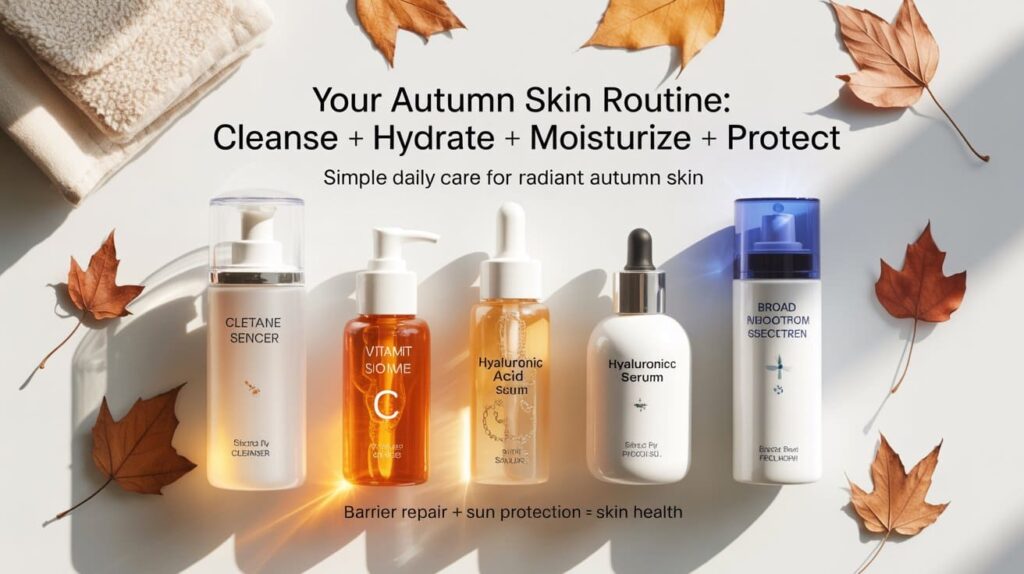
Easy autumn skincare routine (morning & night) — checklist
Morning
- Gentle cleanser (lukewarm).
- Antioxidant serum (Vitamin C) — optional.
- Lightweight hyaluronic acid serum (apply to damp skin).
- Barrier moisturizer with ceramides and glycerin.
- Broad-spectrum SPF 30+ (reapply if outdoors). PMCOrganisation mondiale de la santé
Night
- Gentle cleanse.
- Targeted treatment (low-strength retinoid alternate nights or niacinamide if sensitive).
- Rich barrier cream or occlusive over moisturizer on very dry nights.
- Spot treat or overnight mask for extra hydration once or twice weekly. PMC
Key points
- Autumn skin care should prioritize barrier repair, hydration, and antioxidant support. PMC+1
- Use moisturizers with ceramides + humectants to reduce TEWL and improve texture. PMC+1
- Maintain daily SPF year-round; UV damage continues even on cloudy fall days. Organisation mondiale de la santé
- Eat a diet rich in omega-3s, vitamin C, protein, zinc, and polyphenols to support skin structure and resilience. Wiley Online LibraryPMC
- Consider evidence-backed supplements only after assessing diet and, where appropriate, consulting a clinician. PMC
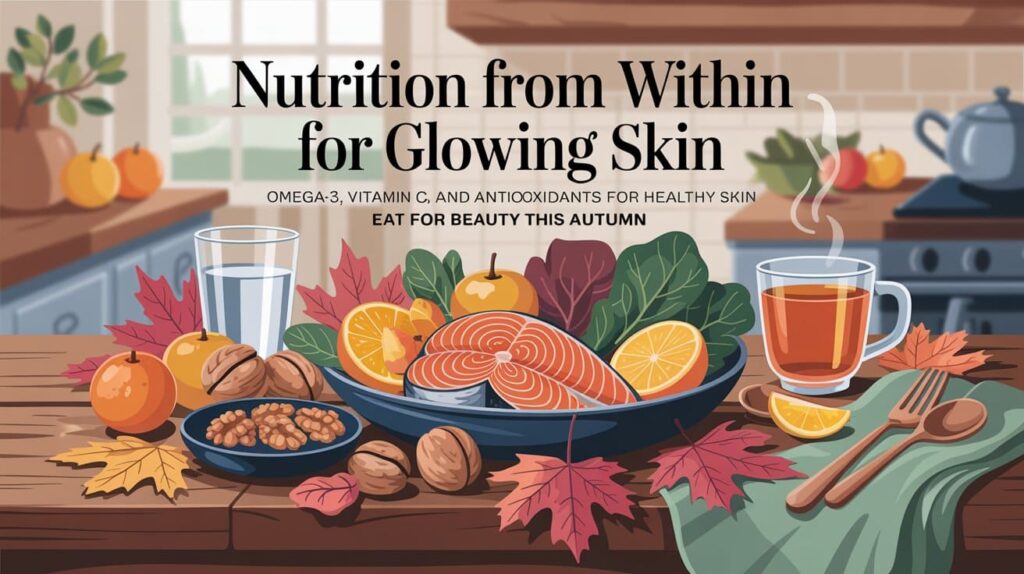
Quick figure — nutrient checklist for autumn skin
| Priority | Nutrient/Action | How often |
|---|---|---|
| 1 | Ceramide-rich moisturizer (AM & PM) | Daily |
| 2 | Daily SPF 30+ | Every morning; reapply if outdoors |
| 3 | Hyaluronic acid (serum) | Daily on damp skin |
| 4 | Increase omega-3s & Vitamin C (diet or supplement) | Daily |
| 5 | Check Vitamin D (blood test in low-sun months) | Once, then as advised |
(Studies support the role of barrier lipids and nutritional antioxidants in improving skin hydration and function). PMCWiley Online Library
Conclusion
Autumn skin and beauty care is best achieved by a two-track strategy: feed the skin from within with a nutrient-rich, anti-inflammatory diet and sensible supplements when needed; and care for the skin from outside by prioritizing gentle cleansing, barrier-repair ingredients (especially ceramides and humectants), and year-round sun protection. Scientific reviews from nutritional dermatology and clinical trials on topical barrier therapies reinforce this balanced approach—protecting the skin’s structure and function reduces dryness, sensitivity, and premature aging as seasons change. Start with small, consistent changes: upgrade your moisturizer, boost daily antioxidants through food, and keep SPF on your fall counter. Your skin will thank you. PMC+1Organisation mondiale de la santé
References (selected)
- Januszewski J, et al. Nutritional Supplements for Skin Health—A Review. (2023). PubMed Central. PMC
- Assaf S, et al. Nutritional Dermatology: Optimizing Dietary Choices for Skin Health. (2024). PubMed Central. PMC
- Jiang W, et al. Seasonal changes in the physiological features of healthy skin. (2022). PubMed. PubMed
- Green M. Transepidermal water loss (TEWL): Environment and… (2022). PubMed Central. PMC
- Nugroho WT, et al. The Efficacy of Moisturisers Containing Ceramide… (2023). PubMed Central. PMC
- Filon FL, et al. Effectiveness of a Skin Care Program With a Cream… (2023). PubMed Central. PMC
- WHO. Radiation: Protecting against skin cancer. (2024). World Health Organization guidance on sunscreen and photoprotection. Organisation mondiale de la santé
- Yong TL. Ceramides and Skin Health: New Insights. (2025). Experimental Dermatology / Wiley. Wiley Online Library
- (Nutrition & antioxidants) Potential Role of Dietary Antioxidants During Skin Aging. (2025). Wiley. Wiley Online LibraryScienceDirect
- Theodorou IM, et al. Cosmeceuticals: A Review of Clinical Studies… (2024). PubMed Central (probiotics/postbiotics). PMC
